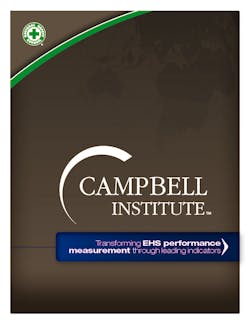NSC 2013: Transforming EHS Performance Measurement through Leading Indicators
Lagging indicators, such as injury rates and fatalities, measure what already has happened. Ideally, EHS professionals would like to prevent these incidents from occurring. Many are turning to leading indicators – such as employee participation in safety, executive compensation that’s tied to safety performance, safety perception surveys, safety training and corrective action measurements – to try to create a relationship between them and the ability to predict and prevent injuries and fatalities.
The Campbell Institute – the National Safety Council’s center of excellence for environmental, health and safety management – shared a new white paper titled, “Transforming EHS Performance Measurement through Leading Indicators” at the 2013 NSC Congress & Expo.
“Transforming EHS Performance Measurement through Leading Indicators” provides a definition of leading indicators, developed by a panel of EHS experts, and describes eight critical characteristics of successful leading indicators. It also suggests multiple ways in which leading indicators can be categorized and identifies several key enablers of successful leading indicator implementation and use, including:
- Executive buy-in on (not technical knowledge of) leading indicators.
- Roll-up and use of leading indicators at the corporate level.
- Communication and understanding of the predictive value of leading indicators by EHS and corporate leadership.
- Targeted leading indicator data collection used to analyze specific measurable actions rather than collected prior to development of response actions.
The study began with a panel discussion with industry experts to explore the meaning of the term leading indicator and the relationship between leading and lagging indicators, identify desirable characteristics of leading indicators, and discuss practical applications of information provided by leading indicators regarding EHS performance. The panel included a total of 17 experts, including 15 practitioners (14 active and one retired) and two researchers. All panelists identified EHS, or occupational safety and health, as their primary area of expertise. Three panelists – two practitioners and one researcher – were employed in the public sector.
Initially, participants of the expert panel were asked to name and describe the most utilized leading indicator of EHS performance at their organization. Responses were extremely varied, ranging from safety work order completion rates to employee participation in EHS training, from management engagement metrics to health assessments. Whereas some organizations utilized simple leading metrics (e.g., tracking the closing of actions against EHS audits, near-miss incidents), others had multi-component indices.
Participants also engaged in a discussion of the differences between leading and lagging indicators.
Although the ability to distinguish between leading and lagging indicators was deemed vital to EHS performance measurement, participants acknowledged that there may be areas where the line is blurred. Some specific examples mentioned included near-miss incidents and root cause analyses.
Leading and lagging indicators were talked about as being separate points on a continuum, and creating a sense of balance between the two in designing performance measurement strategies was considered of major importance
Survey participants noted that the major types of leading metrics that companies track at the corporate level were:
- Behavior-based observations (e.g., safe or unsafe behaviors);
- Near-miss incidents (e.g., incidents with serious injury or fatality potential);
- Audits (e.g., tracking overdue audit items, monitoring the speed of closing action items);
- Training (e.g., EHS training for workers, managers, executives);
- Meetings (e.g., EHS committee, management review, action planning); and
- Other actions (e.g., noncompliance, incident investigation, EHS ideas and suggestions).
The paper also identifies several common barriers to successful leading indicator implementation and use, including:
- Inability to develop consistently actionable leading indicators.
- Lack of reliable, consistent relationship between leading and lagging indicator performance.
- Sporadic, infrequent and non-standardized benchmarking.
- Continuing C-suite reliance on traditional lagging indicators.
“In its inaugural year, the Campbell Institute has made great strides as a transformative force in EHS,” said Mike Gambrell, chairman of the Campbell Institute. “Releasing new research, such as this white paper on leading indicators, and engaging many volunteers, the Institute is sharing best practices and lessons from world class safety performers to impact EHS performance worldwide.”
About the Author

Sandy Smith
Sandy Smith is the former content director of EHS Today, and is currently the EHSQ content & community lead at Intelex Technologies Inc. She has written about occupational safety and health and environmental issues since 1990.
